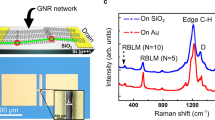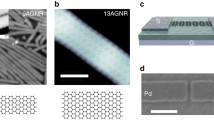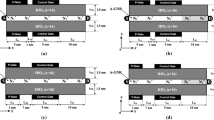Abstract
A simulation-based study of an n-type six-dimer-line armchair graphene nanoribbon (6-AGNR) tunnel field-effect transistor with asymmetric reservoir doping density is carried out. Tunnel field-effect transistor (TFET) structures are proposed based on a detailed investigation of the device behavior for different applied voltages, channel lengths, temperatures, insulator thicknesses, dielectric constants, and source impurity molar fractions. By suppressing the tunneling transmission in the off-state, the channel length of the device using HfO2 can be scaled down to 5 nm without increasing the leakage current. When using a supply voltage of 0.4 V, the ION/IOFF ratio reaches a high value of 3.6 × 1010 for the device with a 5-nm channel. Besides, a subthreshold swing (SS) of 3.8 mV/dec is measured for the same GNR-TFET. The high-performance 10-nm-channel device, when supplied with 0.6 V, exhibits a boosted ION value of up to 4.3 × 103 µA/µm, with SS, gm, and Dini values of 28 mV/dec, 11 µS, and 11 fs, respectively. Nevertheless, conventional GNR-TFETs with various channel lengths exhibit rather outstanding characteristics. Such 6-AGNR TFETs display promising functionality for application in future digital and analog integrated circuits.








Similar content being viewed by others
Reference
Seabaugh, A.C., Zhang, Q.: Low-voltage tunnel transistors for beyond CMOS logic. Proc. IEEE (2010). https://doi.org/10.1109/JPROC.2010.2070470
Sarkar, D., Xie, X., Liu, W., Cao, W., Kang, J., Gong, Y., Kraemer, S., Ajayan, P.M., Banerjee, K.: A subthermionic tunnel field-effect transistor with an atomically thin channel. Nature (2015). https://doi.org/10.1038/nature15387
Ilatikhameneh, H., Ameen, T., Novakovic, B., Tan, Y., Klimeck, G., Rahman, R.: Saving Moore’s law down to 1 nm channels with anisotropic effective mass. Sci. Rep. (2016). https://doi.org/10.1038/srep31501
Ionescu, A.M., Riel, H.: Tunnel field-effect transistors as energy-efficient electronic switches. Nature (2011). https://doi.org/10.1038/nature10679
Nirschl, Th., Henzler, St., Fischer, J., Fulde, M., Bargagli-Stoffi, A., Sterkel, M., Sedlmeir, J., Weber, C., Heinrich, R., Schaper, U., Einfield, J., Neubert, R., Feldmann, U., Stahrenberg, K., Ruderer, E., Georgakos, G., Huber, A., Kakoschke, R., Hansch, W., Schmitt-Landsiedel, D.: Scaling properties of the tunneling field effect transistor (TFET): device and circuit. Solid-State Electron (2006). https://doi.org/10.1016/j.sse.2005.10.045
Wang, P.-F., Hilsenbeck, K., Nirschl, Th., Oswald, M., Stepper, Ch., Weis, M., Schmitt-Landsiedel, D., Hansch, W.: Complementary tunneling transistor for low power application. Solid-State Electron (2004). https://doi.org/10.1016/j.sse.2004.04.006
Chhowalla, M., Jena, D., Zhang, H.: Two-dimensional semiconductors for transistors. Nat. Rev. Mater. (2016). https://doi.org/10.1038/natrevmats2016.52
Schwierz, F.: Graphene transistors: status, prospects, and problems. Proc. IEEE (2013). https://doi.org/10.1109/JPROC.2013.2257633
Gholipour, M., Chen, Y.-Y., Sangai, A., Masoumi, N., Chen, D.: Analytical SPICE-compatible model of Schottky-barrier-type GNRFETs with performance analysis. IEEE Trans. Very Large Scale Integr. VLSI Syst. (2016). https://doi.org/10.1109/TVLSI.2015.2406734
Chilstedt, S., Dong, C., Chen, D.: Carbon nanomaterials transistors and circuits. In: Transistors: Types, Materials and Applications. Nova Science Publication, New York (2010)
Nakada, K., Fujita, M., Dresselhaus, G., Dresselhaus, M.S.: Edge state in graphene ribbons: nanometer size effect and edge shape dependence. Phys. Rev. B (1996). https://doi.org/10.1103/PhysRevB.54.17954
Son, Y.-W., Cohen, M.L., Louie, S.G.: Energy gaps in graphene nanoribbons. Phys. Rev. Lett. (2006). https://doi.org/10.1103/PhysRevLett.97.216803
Wagner, P., Ewels, C.P., Adizian, J.-J., Magaud, L., Pochet, P., Roche, S., Lopez-Bezanilla, A., Ivanovskaya, V.V., Yaya, A., Rayson, M., Briddon, P., Humbert, B.: Band gap engineering via edge-functionalization of graphene nanoribbons. J. Phys. Chem. (2013). https://doi.org/10.1021/jp408695c
Zhang, Q., Fang, T., Xing, H., Seabaugh, A., Jena, D.: Graphene nanoribbon tunnel transistors. IEEE Electron Device Lett. (2008). https://doi.org/10.1109/LED.2008.2005650
Chin, S.-K., Seah, D., Lam, K.-T., Samudra, G.S., Liang, G.: Device physics and characteristics of graphene nanoribbon tunneling FETs. IEEE Trans. Electron Devices (2010). https://doi.org/10.1109/TED.2010.2065809
Kim, S.G., Luisier, M., Boykin, T.B., Klimeck, G.: Computational study of heterojunction graphene nanoribbon tunneling transistors with p-d orbital tight-binding method. Appl. Phys. Lett. (2014). https://doi.org/10.1063/1.4884199
Mech, B.C., Koley, K., Kumar, J.-J.: The understanding of SiNR and GNR TFETs for analog and RF application with variation of drain-doping molar fraction. IEEE Trans. Electron Devices (2018). https://doi.org/10.1109/TED.2018.2867443
Suhendi, E., Hasanah, L., Rusdiana, D., Noor, F.A., Kurniasih, N., Khairurrijal: and, Comparison of tunneling currents in graphene nanoribbon tunnel field effect transistors calculated using Dirac-like equation and Schrödinger’s equation. J. Semicond. (2019). https://doi.org/10.1088/1674-4926/40/6/062002
Knoch, J., Mantl, S., Appenzeller, J.: Impact of the dimensionality on the performance of tunneling FETs: Bulk versus one-dimensional devices. Solid-State Electron. (2007). https://doi.org/10.1016/j.sse.2007.02.001
Fiori, G., Iannaccone, G., Klimeck, G.: A three-dimensional simulation study of the performance of carbon nanotube field-effect transistors with doped reservoirs and realistic geometry. IEEE Trans. Electron Devices (2006). https://doi.org/10.1109/TED.2006.878018
Fiori, G., Iannaccone, G.: Performance analysis of graphene bilayer transistors through tight-binding simulations. In: Proceedings of the 13th International Workshop Computational Electronics (IWCE), Beijing, China, pp. 1–4 (2009). https://doi.org/10.1109/IWCE.2009.5091138
Datta, S.: Nanoscale device modeling: the Green’s function method. Superlattices Microstruct. (2000). https://doi.org/10.1006/spmi.2000.0920
Grassi, R., Poli, S., Gnani, E., Gnudi, A., Reggiani, S., Baccarani, G.: Tight-binding and effective mass modeling of armchair graphene nanoribbon FETs. Solid-State Electron. (2009). https://doi.org/10.1016/j.sse.2008.07.015
Trellakis, A., Galick, A.T., Pacelli, A., Ravaioli, U.: Iteration scheme for the solution of the two-dimensional Schrödinger–Poisson equations in quantum structures. J. Appl. Phys. (1997). https://doi.org/10.1063/1.365396
Conzatti, F., Pala, M.G., Esseni, D., Bano, E., Selmi, L.: Strain-induced performance improvements in InAs nanowire tunnel FETs. IEEE Trans. Electron Devices (2012). https://doi.org/10.1109/TED.2012.2200253
Yan, R.-H., Ourmazd, A., Lee, K.F.: Scaling the Si MOSFET: from bulk to SOI to bulk. IEEE Trans. Electron Devices (1992). https://doi.org/10.1109/16.141237
Appenzeller, J., Knoch, J., Bjoerk, M., Riel, H., Schmid, H.: Toward nanowire electronics. IEEE Trans. Electron Devices (2008). https://doi.org/10.1109/TED.2008.2008011
Knoch, J., Appenzeller, J.: Tunneling phenomena in carbon nanotube field-effect transistors. Phys. Status Solid (a) (2008). https://doi.org/10.1002/pssa.200723528
Singh, N.K., Sahoo, M.: Investigation on the effect of gate dielectric and other device parameters on digital performance of silicene nanoribbon tunnel FET. IEEE Trans. Electron Devices (2020). https://doi.org/10.1109/TED.2020.2992016
Sandow, C., Knoch, J., Urban, C., Zhao, Q.-T., Mantl, S.: Impact of electrostatics and doping concentration on the performance of silicon tunnel field-effect transistors. Solid-State Electron (2009). https://doi.org/10.1016/j.sse.2009.05.009
Lv, Y., Qin, W., Huang, Q., Chang, S., Wang, H., He, J.: Graphene nanoribbon tunnel field-effect transistor via segmented edge saturation. IEEE Trans. Electron Devices (2017). https://doi.org/10.1109/TED.2017.2691360
Zhang, W., Ragab, T., Basaran, C.: Electrostatic doping-based all GNR tunnel FET: an energy-efficient design for power electronics. IEEE Trans. Electron Devices. (2019). https://doi.org/10.1109/TED.2019.2896315
Shirazi, S.G., Karimi, G.R., Mirzakuchakimid, S.: GAA CNT TFETs structural engineering: a higher ON current, lower ambipolarity. IEEE Trans. Electron Devices (2019). https://doi.org/10.1109/TED.2019.2912950
Luong, G.V., Strangio, S., Tiedemannn, A., Lenk, S., Trellenkamp, S., Bourdelle, K.K., Zhao, Q.T., Mantl, S.: Experimental demonstration of strained Si nanowire GAA n-TFETs and inverter operation with complementary TFET logic at low supply voltages. Solid-State Electron. (2016). https://doi.org/10.1016/j.sse.2015.08.020
Hwang, W.S., Zhao, P., Kim, S.G., Yan, R., Klimeck, G., Seabaugh, A., Fullerton-Shirey, S.K., Xing, H.G., Jena, D.: Room-temperature graphene-nanoribbon tunneling field-effect transistors. npj 2D Mater. Appl. (2019). https://doi.org/10.1038/s41699-019-0127-1
International Technology Roadmap for Semiconductor, Accessed on, 20 Dec 2016, [Online]. http://www.itrs2.net/
Acknowledgements
The authors acknowledge the funding support of Babol Noshirvani University of Technology through grant program no. BNUT/389023/99.
Author information
Authors and Affiliations
Corresponding author
Additional information
Publisher’s Note
Springer Nature remains neutral with regard to jurisdictional claims in published maps and institutional affiliations.
Rights and permissions
About this article
Cite this article
Aghanejad Ahmadchally, A., Gholipour, M. Investigation of 6-armchair graphene nanoribbon tunnel FETs. J Comput Electron 20, 1114–1124 (2021). https://doi.org/10.1007/s10825-021-01709-4
Received:
Accepted:
Published:
Issue Date:
DOI: https://doi.org/10.1007/s10825-021-01709-4




